A crisp November morning in Japan, and the country’s shrines come alive with the sound of children’s laughter and the rustle of silk kimono.
Families dressed in their finest traditional attire make their way through ancient torii gates, their young ones clutching bags of special candy while beaming with excitement.
This heartwarming scene captures the essence of Japanese Shichi-go-san (七五三), one of Japan’s most treasured cultural celebrations.
Shichi-go-san, literally meaning “seven-five-three,” is a traditional Japanese festival that honors children at these specific milestone ages.
The celebration focuses on three and seven-year-old girls, along with five-year-old boys, marking crucial developmental stages in their young lives.
While the sight of elaborately dressed children might seem like an elaborate photo session to outsiders, this ancient tradition runs far deeper than its photogenic surface.
In Japanese culture, Shichigosan represents much more than a charming family outing. It serves as a profound expression of gratitude for children’s health and growth, while simultaneously invoking divine protection for their future.
The festival embodies the Japanese values of family unity, respect for tradition, and reverence for life’s precious moments.
For parents, it’s an opportunity to pause amid busy modern life and formally acknowledge their children’s development while expressing hopes for continued prosperity and happiness.
The cultural significance of Shichigosan extends beyond individual families to encompass broader themes of community continuity and cultural preservation.
In a rapidly modernizing society, this tradition serves as a bridge between Japan’s historical roots and contemporary life, ensuring that ancient wisdom and customs remain relevant for new generations.
The festival’s enduring popularity across all social classes demonstrates its fundamental importance to Japanese identity and values.
Historical Origins
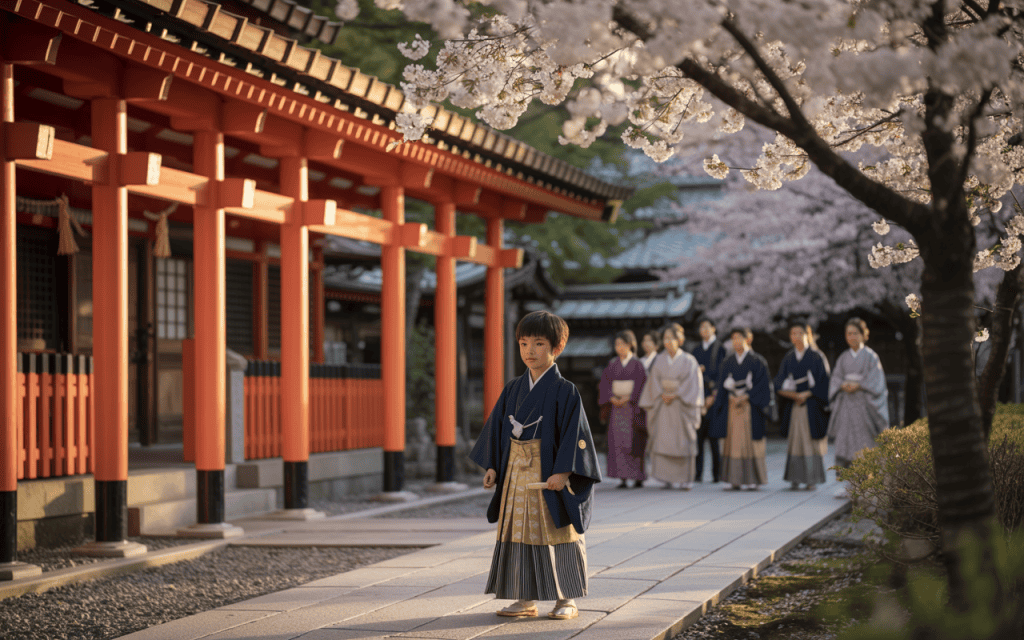
The roots of Shichigosan stretch back over a millennium to Japan’s elegant Heian period (794–1185), when the imperial court in Kyoto set the standards for cultural refinement and spiritual practice.
During this golden age of Japanese culture, aristocratic families began observing elaborate coming-of-age ceremonies for their children, recognizing specific ages as particularly significant for spiritual and social development.
Initially, these ceremonies were exclusive privileges of the court nobility, who had both the leisure time and financial resources to conduct elaborate rituals.
The Heian court’s sophisticated understanding of Chinese numerology and Buddhist philosophy influenced the selection of ages three, five, and seven as particularly auspicious milestones.
These early celebrations were deeply intertwined with religious beliefs about spiritual protection and the precarious nature of childhood survival.
As Japan’s social structure evolved through the Kamakura and Muromachi periods, the samurai class gradually adopted and adapted these aristocratic practices.
Warrior families recognized the value of formal recognition for their children’s development, particularly given the uncertain times and frequent conflicts that characterized medieval Japan.
The samurai emphasized martial virtues and family honor, adding their own elements to the ceremonies while maintaining the core spiritual components.
The most significant expansion of Shichigosan occurred during the Edo period (1603–1868), when increasing prosperity and social stability allowed merchant and artisan classes to participate in previously exclusive aristocratic customs.
The Tokugawa shogunate’s emphasis on social order and cultural preservation helped standardize and spread the tradition throughout Japanese society.
By the Meiji period (1868–1912), Shichigosan had become a truly national celebration embraced by families across all social strata.
The historical context that made Shichigosan so meaningful was the harsh reality of high infant and child mortality rates.
In pre-modern Japan, surviving to ages three, five, and seven represented genuine achievements worthy of celebration and divine thanksgiving.
Parents who successfully guided their children through these vulnerable early years had reason for both gratitude and continued prayers for protection.
This practical foundation gave the festival its emotional resonance and spiritual urgency that continues to influence modern celebrations.
Traditional Customs and Rituals
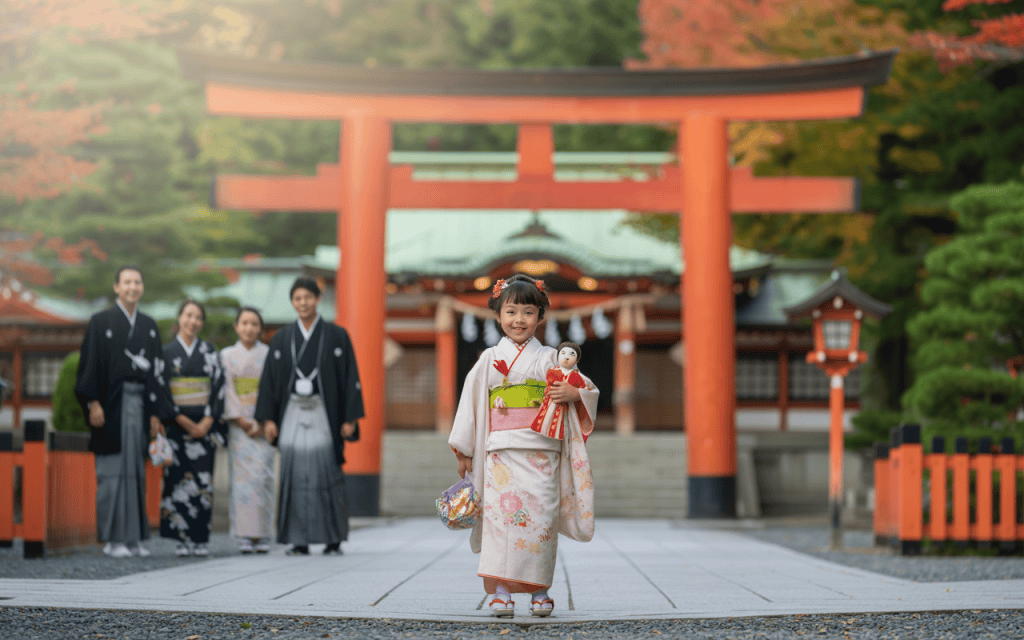
Age-specific Rites
The beauty of Shichigosan lies in its recognition that each celebrated age represents distinct developmental milestones requiring unique acknowledgment and spiritual attention.
These age-specific ceremonies, refined over centuries of practice, create meaningful transitions that help children understand their growing responsibilities and social roles.
At age three, both boys and girls participate in Kamioki (髪置), the “hair-leaving” ceremony that marks a fundamental shift in their physical appearance and social status.
In traditional Japan, children’s heads were kept shaved during their earliest years for practical reasons related to hygiene and health.
The Kamioki ceremony celebrated the first time children were allowed to grow their hair naturally, symbolizing their emergence from the most vulnerable period of infancy into early childhood.
This transition represented not just physical development but also the beginning of formal social recognition as individuals with distinct personalities and potential.
The five-year milestone brings Hakamagi-no-Gi (袴着の儀), exclusively for boys, marking their first wearing of hakama trousers.
This ceremony represents a profound transition from the gender-neutral clothing of early childhood to distinctly masculine attire that connects boys with adult male social roles.
The hakama, with its complex ties and formal structure, requires skill and maturity to wear properly, making this ceremony a practical test of the child’s developing coordination and social awareness.
Historically, this transition marked the beginning of more serious education and training in masculine pursuits, whether martial arts for samurai families or trade skills for merchant classes.
Seven-year-old girls experience Obitoki-no-Gi (帯解の儀), their first formal wearing of an obi sash with kimono.
This elaborate ceremony marks the transition from simple childhood clothing to the complex, sophisticated dress of young ladies.
Learning to properly wear and manage an obi requires considerable skill and represents a girl’s first steps toward the intricate world of adult feminine social customs.
The ceremony symbolizes growing maturity, grace, and preparation for future roles as women in Japanese society.
The complexity and beauty of the obi also represent the family’s hopes for their daughter’s refinement and social success.
Clothing
The visual splendor of Shichigosan centers on the elaborate traditional clothing that transforms ordinary children into living embodiments of Japanese cultural artistry.
These garments represent far more than mere costume; they serve as tangible connections to family heritage, regional identity, and cultural continuity that spans generations.
Children’s kimono for Shichigosan feature the finest materials families can afford, often becoming treasured heirlooms passed down through generations.
The fabrics showcase traditional Japanese textile arts: silk brocades with intricate woven patterns, hand-painted designs featuring seasonal motifs, and embroidered details that demonstrate master craftsmanship.
Colors carry symbolic meaning, with bright reds representing vitality and protection, while gold accents suggest prosperity and good fortune.
Boys’ hakama and haori combinations create striking formal silhouettes that emphasize dignity and emerging masculinity.
The hakama’s wide legs and formal pleating require careful movement, teaching boys about proper posture and graceful deportment.
Family crests (mon) prominently displayed on the haori connect children to their ancestral lineage and social heritage.
The color choices often reflect seasonal appropriateness, with deep blues, blacks, and earth tones creating sophisticated, masculine impressions.
Girls’ kimono showcase the full spectrum of Japanese aesthetic sensibility, with long sleeves (furisode) creating elegant silhouettes that emphasize youth and beauty.
The obi selection becomes an art form in itself, with elaborate brocades and complex tying techniques creating stunning focal points.
Hair ornaments, often featuring traditional motifs like cherry blossoms or chrysanthemums, complete the ensemble while connecting girls to seasonal cycles and natural beauty.
Regional variations add fascinating diversity to Shichigosan attire. Kyoto families often prefer subtle, refined color palettes that reflect the ancient capital’s sophisticated aesthetic traditions.
Tokyo celebrations might feature more bold, contemporary interpretations of traditional designs. Rural areas often maintain older regional patterns and techniques that preserve local textile traditions and cultural identity.
The increasing presence of Western-style formal wear represents modern adaptations to changing lifestyles and international influences.
Some families choose elegant suits for boys or party dresses for girls, particularly when traditional kimono rental proves prohibitively expensive or impractical.
However, even these modern adaptations usually incorporate traditional elements like formal photography in kimono or the inclusion of traditional accessories that maintain cultural connections.
Shrine Visits
The spiritual heart of Shichigosan lies in family visits to Shinto shrines, where ancient rituals connect celebrants to divine protection and community blessings.
These visits transform personal family milestones into sacred experiences that honor both individual growth and collective cultural heritage.
Shinto shrines provide the perfect setting for Shichigosan celebrations, with their emphasis on purification, natural harmony, and life-affirming spirituality.
The approach to the shrine begins the spiritual journey, as families pass through torii gates that mark the transition from mundane daily life to sacred space.
The act of walking along shrine pathways, often lined with ancient trees and traditional lanterns, creates a meditative atmosphere that prepares participants for meaningful spiritual engagement.
The purification ritual at the temizuya (water basin) serves as both practical preparation and symbolic cleansing.
Children learn the proper sequence of washing hands and rinsing mouths, participating in ancient practices that connect them to generations of worshippers.
This ritual teaches respect for sacred spaces while providing a moment of quiet preparation before approaching the main shrine building.
Prayer ceremonies conducted by Shinto priests add formal spiritual weight to the celebration. These trained religious practitioners offer specialized blessings for children’s health, protection, and future prosperity.
The ceremonies often include traditional music, ritual movements, and ancient prayers that create powerful spiritual experiences for participating families.
Children witness adult reverence for divine forces while receiving personal attention from respected religious authorities.
The custom of offering monetary gifts (saisen) teaches children about reciprocity with divine forces and support for religious institutions.
Writing wishes on ema plaques provides tangible ways for families to express their hopes and concerns while participating in community spiritual practices.
These wooden plaques, often featuring shrine-specific designs and seasonal motifs, become permanent parts of the shrine’s spiritual landscape while connecting individual families to broader community prayers.
Modern Celebrations
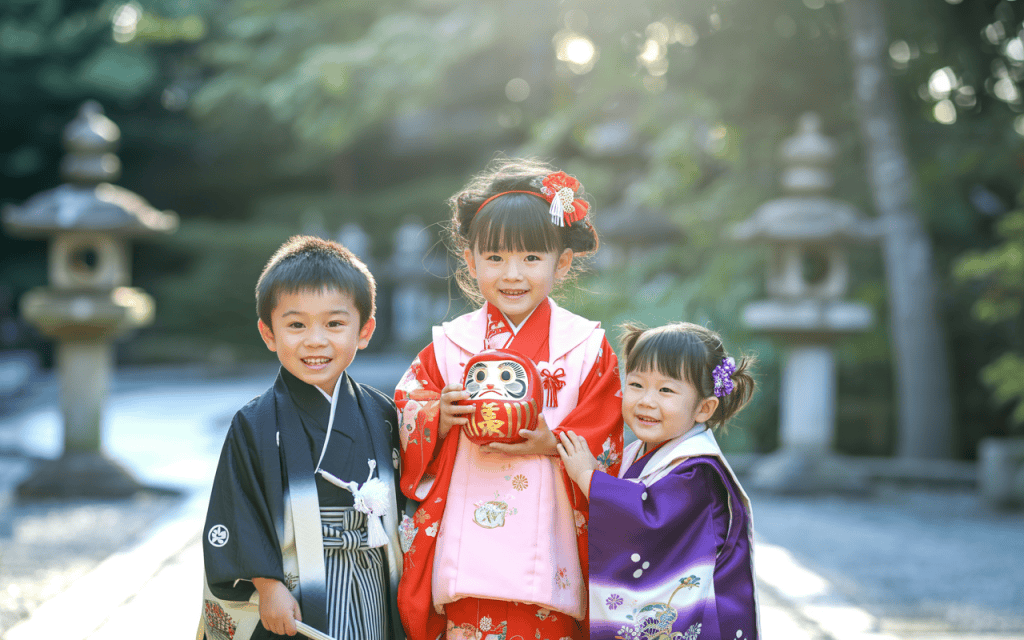
Contemporary Shichi-go-san celebrations beautifully blend ancient traditions with modern conveniences and contemporary family lifestyles.
While maintaining the essential spiritual and cultural components, today’s celebrations have adapted to urban living, busy schedules, and changing social expectations in ways that keep this cherished tradition relevant and accessible.
The timing of modern Shichigosan centers around November 15th, though the date’s significance has evolved from strict adherence to flexible accommodation of family schedules.
While November 15th remains the traditional ideal, most families now celebrate on the nearest convenient weekend, allowing for more elaborate preparations and greater family participation.
This flexibility demonstrates how traditions can adapt to modern life while preserving their essential meaning and significance.
Photography has become an integral component of contemporary Shichigosan celebrations, often rivaling the shrine visit itself in importance and investment.
Professional photographers specializing in traditional family portraits have created an entire industry around capturing these precious moments.
Families often schedule elaborate photo sessions that may include multiple outfit changes, various shrine locations, and carefully orchestrated family groupings that create lasting visual memories.
Studio photography offers weather-independent alternatives that allow for more controlled artistic results.
These professional facilities often feature replica shrine settings, traditional backdrops, and elaborate props that create stunning images without the unpredictability of outdoor shrine visits.
Some studios provide complete service packages including kimono rental, professional styling, and same-day photo processing that appeals to busy modern families.
Celebratory meals have evolved from simple family gatherings to elaborate restaurant celebrations that may include extended family and close friends.
Many restaurants now offer special Shichigosan menus featuring traditional Japanese cuisine presented in child-friendly formats.
These meals serve as opportunities for multiple generations to share in the celebration while creating relaxed environments for family bonding and memory-making.
Regional and family variations continue to influence how modern celebrations unfold. Urban families might emphasize convenience and professional services, while rural families often maintain more traditional approaches that involve community participation and homemade preparations.
Mixed-heritage families increasingly blend Shichigosan with other cultural celebrations, creating unique fusion experiences that honor multiple traditions simultaneously.
Chitose Ame — The Thousand Year Candy
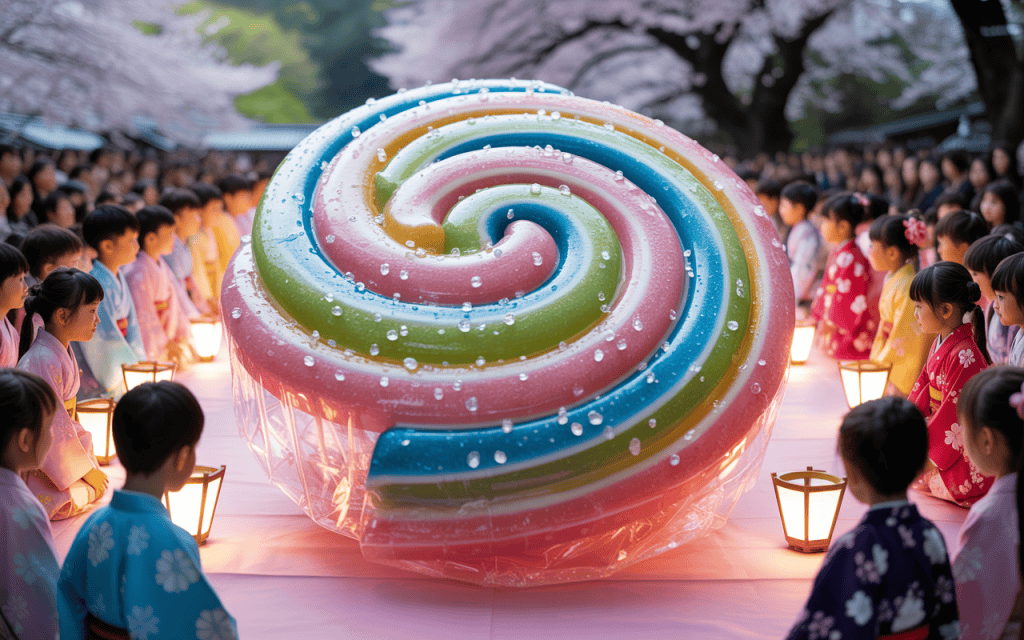
Among all the elements that make Shichigosan special, perhaps none captures children’s hearts quite like chitose ame (千歳飴), the symbolic candy that transforms this spiritual celebration into a delightful treat for young participants.
These special sweets represent far more than simple childhood indulgence; they embody profound wishes for longevity, health, and sweet fortune that will accompany children throughout their lives.
Chitose ame’s distinctive appearance makes it instantly recognizable and deeply meaningful. These long, thin candy sticks stretch much longer than typical sweets, symbolizing the wish for extended life and continued growth.
The traditional red and white coloring carries auspicious meaning in Japanese culture, with red representing vitality and protection against evil, while white signifies purity and new beginnings.
The candy’s hard texture requires patience and careful eating, teaching children to savor good things slowly and appreciate life’s sweet moments.
The length of chitose ame sticks traditionally corresponds to the child’s height, creating a personal connection between the candy and the individual celebrant.
This customization makes each child’s candy unique while reinforcing the personal nature of the blessings and wishes accompanying the treat.
Some regions maintain the practice of having candy specially made to match each child’s measurements, though commercial versions now offer standardized lengths that still maintain the symbolic significance.
The packaging of chitose ame transforms simple candy into treasured keepsakes that families often preserve long after the sweets are consumed.
Traditional bags feature hand-painted or printed designs showcasing cranes and turtles, both revered in Japanese culture as symbols of longevity and good fortune.
Cranes, believed to live for a thousand years, represent hopes for extended life and happiness. Turtles, associated with wisdom and steadiness, symbolize wishes for stable, thoughtful development throughout childhood and beyond.
Modern chitose ame packaging has evolved to include popular cartoon characters, contemporary designs, and even personalized elements that appeal to today’s children while maintaining traditional symbolic elements.
Some families commission custom bags featuring family crests, children’s names, or special messages that create unique mementos of the celebration.
These personalized touches help modern children connect with ancient traditions through familiar, appealing presentations.
The tradition of giving chitose ame extends beyond immediate family to include gifts for siblings, cousins, and family friends who participate in the celebration.
This sharing aspect reinforces community bonds while ensuring that the blessings and good wishes associated with the candy reach beyond the primary celebrants to encompass broader family and social networks.
Key Locations and Regional Variations
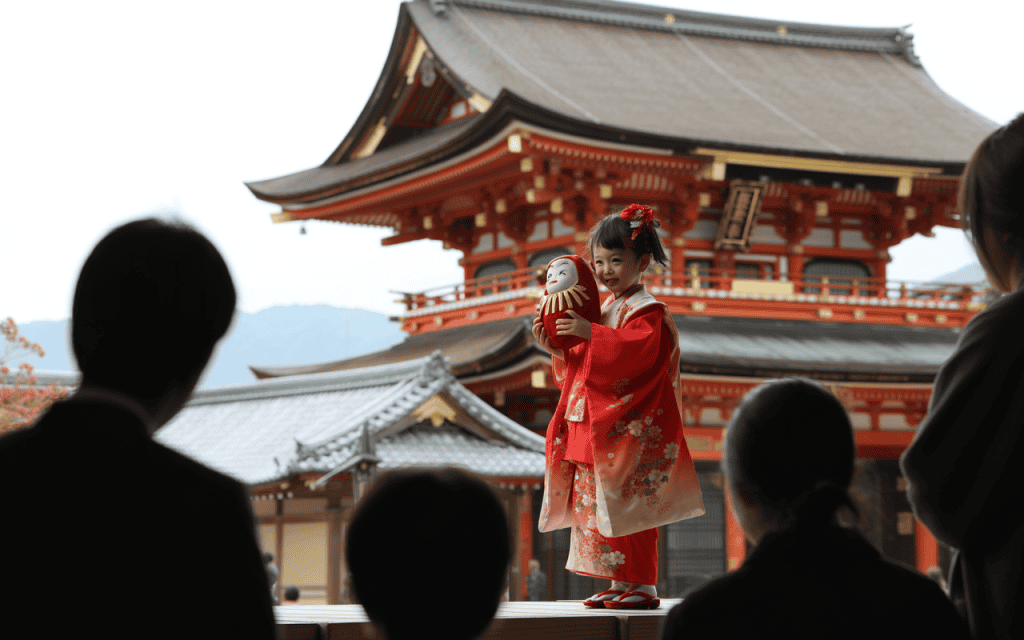
When it comes to Shichigosan celebrations, location truly matters, and Japan offers an incredible array of shrine options that cater to different spiritual needs, aesthetic preferences, and practical considerations.
Each major shrine brings its unique character and special significance to this cherished family tradition.
Tokyo’s Meiji Jingū stands as perhaps the most iconic destination for Shichigosan celebrations, attracting families from across the metropolis and beyond.
This magnificent shrine, dedicated to Emperor Meiji and Empress Shōken, offers an oasis of tranquility amid urban intensity.
The approach through ancient forest pathways creates a magical transition from city life to sacred space, while the shrine’s expansive grounds provide numerous photographic opportunities featuring traditional architecture against natural backdrops.
The shrine’s association with modernization and progress makes it particularly meaningful for families hoping their children will thrive in contemporary Japan.
Hie Jinja, nestled in the heart of Tokyo near the Imperial Palace, provides a more intimate setting that appeals to families seeking traditional atmosphere without overwhelming crowds.
Known for its distinctive tunnel of red torii gates and guardian monkey statues, this shrine offers unique photographic opportunities while maintaining strong connections to prosperity and protection.
The shrine’s elevated position provides beautiful views of the surrounding city, symbolically representing children’s journey toward greater heights and broader perspectives.
For families prioritizing academic success and intellectual development, Kanda Myōjin reigns supreme among Tokyo’s shrine options.
This vibrant shrine, dedicated to learning, business prosperity, and protection from misfortune, attracts parents hoping their children will excel in their studies and future careers.
The shrine’s blend of ancient traditions with modern amenities, including electronic prayer offerings and contemporary festival elements, appeals to families navigating traditional values within modern lifestyles.
Regional variations across Japan add fascinating cultural depth to Shichigosan celebrations. Kyoto’s approach emphasizes refined aesthetic sensibility and historical continuity, with families often choosing Fushimi Inari Taisha for its thousands of vermillion torii that create stunning photographic backdrops.
The ancient capital’s celebrations tend toward more formal, traditional presentations that reflect the city’s role as guardian of Japanese cultural heritage.
Osaka and the broader Kansai region often feature more elaborate, colorful celebrations that reflect the area’s merchant culture and appreciation for display and entertainment.
Families in this region might choose larger shrine complexes that accommodate extended family gatherings and more festive celebrations that include community elements and regional specialties.
Northern prefectures like Tohoku maintain particularly traditional approaches to Shichigosan, often incorporating local seasonal elements and community participation that reflect rural values and close-knit social structures.
These celebrations might feature locally-made items, regional food specialties, and multi-generational participation that creates deeper community connections.
The Deeper Meaning of Shichi-go-san
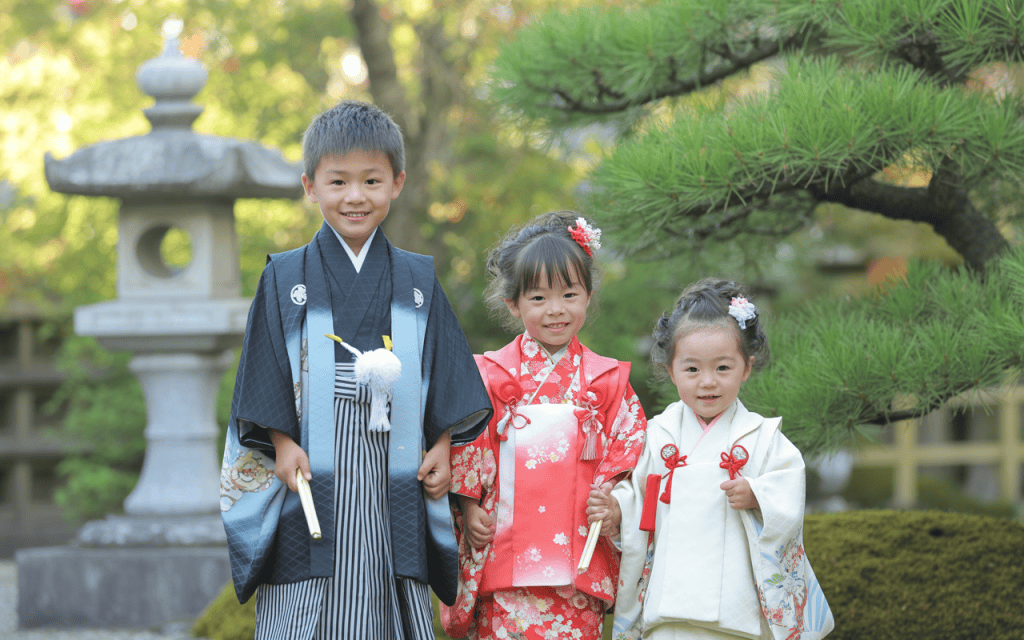
Beneath the beautiful kimono, professional photographs, and festive atmosphere lies a profound spiritual and cultural framework that speaks to fundamental human experiences of growth, gratitude, and hope.
Shichigosan represents far more than a charming tradition; it embodies essential Japanese values while addressing universal themes that resonate across cultures and generations.
As a rite of passage, Shichigosan provides structured recognition of childhood development that helps both children and families navigate the complex journey from infancy to maturity.
The festival creates formal acknowledgement of significant developmental milestones while providing spiritual framework for understanding growth as both personal achievement and divine blessing.
This recognition helps children develop self-awareness and confidence while teaching them to appreciate their progress and potential.
The integration of Shinto spirituality with family bonds creates powerful connections between individual development and broader spiritual forces.
Families approach shrines not merely as tourists or tradition-followers, but as sincere participants in ancient spiritual practices that connect them to divine protection and community blessing.
This spiritual dimension elevates personal celebration to sacred experience while teaching children about reverence, gratitude, and humility before forces greater than themselves.
Parental hopes find profound expression through every aspect of Shichigosan celebration. The careful selection of appropriate dates, the choice of meaningful shrine locations, and the specific prayers offered all reflect parents’ deepest wishes for their children’s health, happiness, and success.
The festival provides formal opportunity for parents to articulate their dreams and concerns while seeking divine assistance in their crucial role as guides and protectors.
The theme of communal continuity runs throughout Shichigosan celebrations, connecting individual families to broader social networks and cultural heritage.
Participating in this ancient tradition creates bonds between past and future, connecting today’s children to countless generations who have marked these same milestones with similar hopes and celebrations.
This continuity provides children with sense of belonging to something larger than immediate family while teaching them about their role in preserving and transmitting cultural values.
The tradition’s remarkable endurance through centuries of dramatic social change demonstrates its fundamental importance to Japanese identity and values.
Despite modernization, urbanization, Western influences, and changing family structures, Shichigosan continues to thrive because it addresses timeless human needs for marking important transitions, expressing gratitude, and connecting with transcendent meaning.
Tips for Foreigners and Visitors
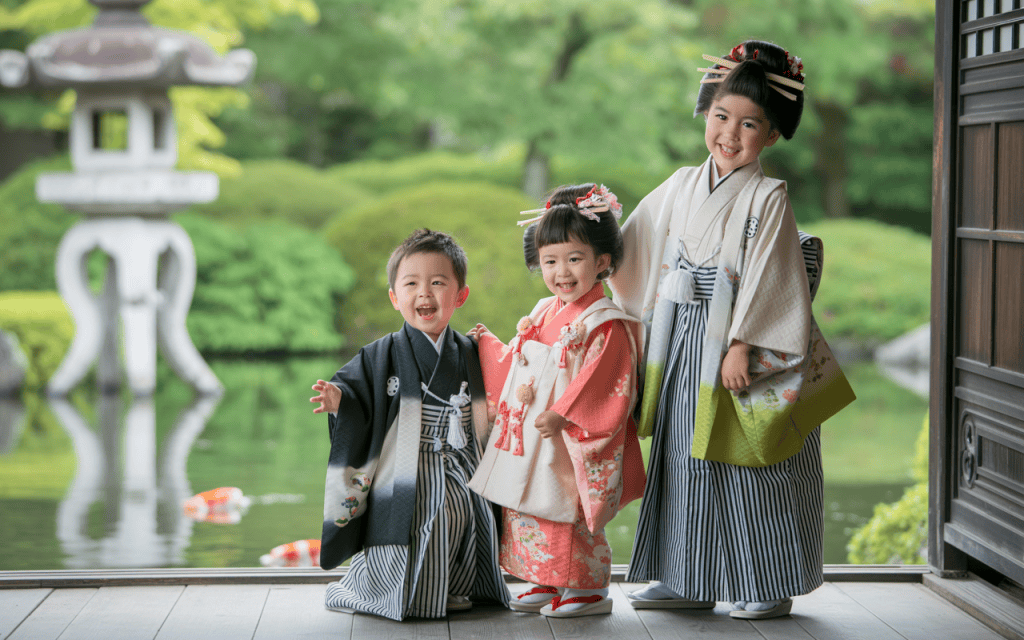
Experiencing Shichigosan as a foreign visitor offers an extraordinary window into Japanese family life, cultural values, and spiritual practices that few tourist experiences can match.
November in Japan provides ideal conditions for shrine visits, with comfortable temperatures, stunning autumn foliage, and the magical atmosphere of families celebrating this cherished tradition.
Respectful observation begins with understanding basic shrine etiquette that demonstrates cultural sensitivity and spiritual awareness.
Always bow respectfully before passing through torii gates, recognizing these structures as sacred thresholds that separate mundane space from spiritual realm.
At the temizuya purification basin, follow the prescribed sequence of washing hands and rinsing mouth, participating in ancient cleansing rituals that prepare visitors for sacred encounters.
Photography guidelines require particular attention during Shichigosan season when families are creating precious memories of their children’s milestones.
While photography is generally permitted in shrine grounds, always avoid using flash during prayer ceremonies or blessing rituals, as this disrupts the spiritual atmosphere and shows disrespect for participants.
Focus on capturing the broader atmosphere of celebration rather than intrusive close-ups of individual families, allowing these precious family moments to unfold naturally without interference.
The interplay of traditional architecture, seasonal foliage, and colorful traditional clothing creates naturally stunning photographic compositions that don’t require intrusive techniques.
Early morning visits often provide the best lighting conditions and fewer crowds, allowing for more peaceful observation and better photography opportunities while showing respect for families who arrive for important ceremonies.
For visitors interested in deeper cultural engagement, many major shrines provide English-language information about shrine history, Shichigosan significance, and proper etiquette for foreign visitors.
Some shrines even welcome respectful international visitors to observe blessing ceremonies from designated areas, providing authentic cultural experiences while maintaining appropriate boundaries.
Consider purchasing ema (wooden wishing plaques) to write your own prayers or well-wishes, contributing positively to the shrine’s spiritual energy while participating meaningfully in traditional practices.
These personal offerings demonstrate respect for local customs while creating tangible connections to Japanese spiritual traditions.
Kimono rental services near major shrines increasingly cater to international visitors interested in authentic cultural participation.
These businesses often provide complete packages including traditional clothing selection, professional dressing assistance, and guidance on proper behavior while wearing formal Japanese attire.
Such experiences offer meaningful cultural participation while supporting local businesses dedicated to preserving traditional crafts and customs.
Transportation planning becomes crucial during peak Shichigosan weekends when popular shrines experience significant crowds and parking challenges.
Public transportation often proves more convenient and environmentally responsible than private vehicles, while early arrival or weekday visits provide more comfortable experiences with better opportunities for meaningful observation and cultural appreciation.
Fun Facts and Frequently Asked Questions

The prominence of odd numbers in Shichi-go-san reflects sophisticated understanding of East Asian numerology that has influenced Japanese culture for over a millennium.
In traditional Japanese belief systems influenced by Chinese philosophy, odd numbers are considered yang (positive energy) and therefore particularly auspicious for important life events.
The specific numbers 3, 5, and 7 carry additional significance as they represent crucial developmental stages that require special spiritual attention and community recognition.
These particular ages correspond to important physical and social developmental milestones that were especially significant in historical Japan.
Age three marked the end of the most vulnerable infancy period when mortality risks decreased significantly.
Five represented childhood’s midpoint when children began more serious education and social training.
Seven indicated preparation for formal schooling and increased social responsibilities that would prepare children for adult roles.
The hair-cutting traditions associated with these ages reflect practical health considerations that evolved into spiritual customs.
Keeping young children’s heads shaved during their earliest years helped prevent lice and other hygiene problems while simplifying care.
Allowing hair growth at age three symbolized successful survival through the most precarious period while marking the beginning of more sophisticated personal care and social presentation.
International Japanese communities worldwide have creatively adapted Shichigosan to local contexts while preserving essential cultural and spiritual elements.
Japanese-American families in Hawaii often combine celebrations with local seasonal festivals, while communities in Brazil might incorporate elements of their multicultural environment.
These adaptations demonstrate the tradition’s flexibility and universal appeal while maintaining core values of family celebration and spiritual gratitude.
Modern trends include elaborate professional photography that extends far beyond traditional shrine visits.
Some families now organize comprehensive photo sessions in multiple locations, featuring various costume changes, seasonal backdrops, and artistic compositions that create extensive visual documentation of their children’s milestones.
Social media influence has encouraged more elaborate presentations and creative interpretations of traditional elements.
The rental industry has evolved into a sophisticated service sector offering complete celebration packages.
Some companies provide transportation, professional photography, catering services, and even cultural interpretation for international families.
However, many traditional families still prefer handmade or inherited clothing, viewing the preparation process as integral to the celebration’s meaning and family bonding.
Participation by mixed-heritage families has led to interesting cultural fusion celebrations that combine Shichigosan with other traditions.
These families might incorporate elements from multiple cultural backgrounds while maintaining the essential Japanese spiritual and family-centered components.
Such adaptations demonstrate how ancient traditions can evolve to remain relevant in increasingly diverse family structures.
Regional specialties add local flavor to Shichigosan celebrations across Japan. Some areas feature unique candy varieties, special shrine decorations, or local customs that reflect regional history and cultural characteristics.
These variations ensure that while the fundamental tradition remains consistent, local communities can express their distinct identity and cultural pride through celebration details.
Conclusion
Shichigosan endures as far more than a charming cultural curiosity or elaborate photography opportunity.
This beloved festival represents the beating heart of Japanese cultural identity, weaving together spiritual reverence, family devotion, and community continuity in ways that speak to universal human experiences of growth, gratitude, and hope for the future.
In our rapidly changing global society, Shichigosan offers a powerful reminder of the importance of marking life’s significant transitions with intention, ceremony, and celebration.
The sight of children dressed in elaborate traditional clothing, their faces glowing with joy and anticipation, connects us to something timeless and profound about the human experience of development and possibility.
This ancient tradition demonstrates how cultural practices can remain vibrantly relevant while adapting to contemporary circumstances and changing social needs.
The festival’s remarkable ability to maintain its essential character while embracing modern adaptations speaks to the strength and flexibility of Japanese cultural values.
Whether celebrated in Tokyo’s grand shrine complexes or small rural communities, whether by traditional Japanese families or international communities worldwide, Shichigosan continues to serve its fundamental purpose: acknowledging children’s precious development while expressing profound hopes for their bright and prosperous futures.
For families participating in Shichigosan, the experience creates memories that span lifetimes and generations.
Children who once wore tiny kimono and clutched chitose ame bags grow up to become parents who carefully select traditional clothing for their own children, perpetuating a beautiful cycle of love, tradition, and hope that connects past, present, and future in meaningful ways.
As Japan continues to navigate the complex balance between preserving cultural heritage and embracing global modernity, Shichigosan stands as an inspiring example of how ancient wisdom can remain vibrantly relevant and emotionally resonant.
In celebrating children’s growth with such ceremony, beauty, and spiritual depth, Japanese culture reminds us all of the preciousness of childhood, the importance of gratitude for life’s blessings, and the enduring power of hope for future generations.
The tradition’s continued popularity across all social classes and its adaptation by international communities worldwide demonstrates its universal appeal and fundamental importance to human experience.
Shichigosan teaches us that growth deserves celebration, that children deserve our best efforts and highest hopes, and that traditions connecting us to something larger than ourselves provide essential meaning and continuity in our lives.
Through elaborate clothing, sacred rituals, family gatherings, and community participation, Shichigosan creates space for reflection on the miracle of children’s development while affirming our collective commitment to nurturing and protecting the next generation.
In this way, an ancient Japanese tradition speaks to universal human values while preserving unique cultural wisdom that enriches our global understanding of childhood, family, and community.
Vocabulary Sidebar
- Hakama: Traditional pleated trousers worn by boys during Shichigosan
- Obi: Elaborate sash worn with girls’ kimono, marking maturity
- Chitose ame: Special “thousand-year candy” symbolizing longevity
- Ema: Wooden wishing plaques hung at shrines for prayers
- Temizuya: Purification water basin at shrine entrances
- Torii: Traditional gates marking entrance to sacred shrine space
- Kamioki: Age-three ceremony allowing children to grow hair
- Hakamagi-no-Gi: Age-five ceremony for boys wearing hakama
- Obitoki-no-Gi: Age-seven ceremony for girls wearing obi
- Mon: Family crests displayed on formal traditional clothing






